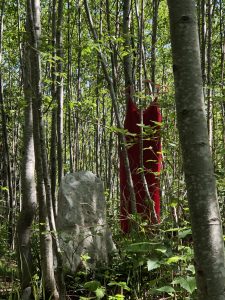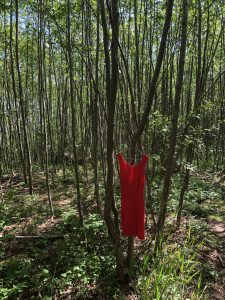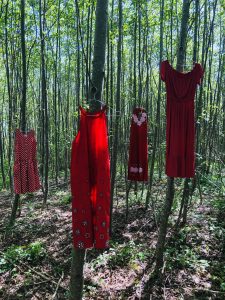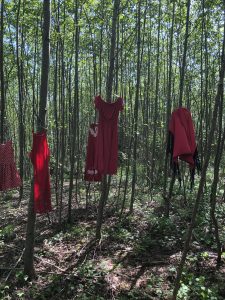By: Alison Wick, Arts Editor
All images courtesy of Kim John
On May 5, the unofficial National Day of Awareness for Missing and Murdered Indigenous Women and Girls (MMIWG), SFU music student Toni Yake (Mohawk) and health sciences student Kim John (Coast Salish) hung seven red dresses in the trees off University Road East on Burnaby Mountain. The bright red dresses were hauntingly beautiful, as the colour red simultaneously evokes femininity, beauty, and blood. Amongst the mossy green hues of the forest, the red dresses and their slight movement in the wind delicately demanded our attention. The dresses are pieces of art that call awareness to an ongoing and unresolved national crisis.


A few days later, Yake went back to visit the dresses and take photos. She found that they had all been removed.
It is disgraceful, to say the least. The seven red dresses were hung with care and intention and were unmistakably put up for a reason. They were a striking visual in the forest — meant to be there and to be together. They are not mere items of clothing; they are meaningful and significant cultural objects anchored in history and protest.
The REDress project was started by interdisciplinary Métis artist Jaime Black in Winnipeg, over six years ago. Red dresses were initially displayed in public spaces as well as in a few gallery exhibitions, notably at the Canadian Museum for Human Rights in 2014, but have now moved from the gallery into grassroots art pieces across the country. As Black outlines on the project website, the project “is an aesthetic response to the more than 1000 missing and murdered [Indigenous women and girls] in Canada.”

Now, the red dresses are an artistic symbol held by the public; anyone anywhere can hang a red dress to create a presence through absence.
It’s heinous that so many missing persons’ cases of women and girls have gone unsolved and ignored by the Canadian government, RCMP, and local police forces, but I don’t want to desensitize this story with numbers. Each dress represents not a statistic but an individual woman and the collective of real women that have been taken from their families and communities.
However, if you are unfamiliar with this issue, I urge you to look at the Native Women’s Association of Canada page’s Understanding MMIWG, the Indigenousefoundations.arts.ubc section on the Marginalization of Aboriginal women, and Amnesty International’s No More Stolen Sisters campaign to learn more about the causes, realities, and channels of support for MMIWG.

The REDress project and its daughter movement are examples of how art can function as a powerful piece of activism. In my first draft, I ended this article encouraging you to take a walk in the forest, and see the dresses hanging in the trees. Since the dresses have been taken down, I encourage you to learn about this issue and reflect on how you are standing in solidarity with Indigenous women and girls and fighting anti-Indigenous misogyny and racism.
For Indigenous students, the Indigenous Student Centre has Indigenous counsellors as well as a smudging area and medicine for all Indigenous students to use.



